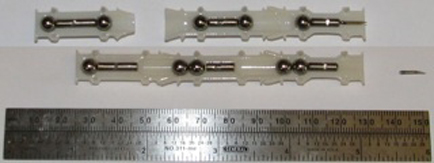Engineering news
Gauss gun components: Researchers drew upon the principles behind a toy called a Gauss gun to insert the robots The use of miniature 3D-printed robots driven by magnetic potential energy from magnetic resonance imaging (MRI) scanners could advance minimally invasive surgery, say researchers from the University of Houston.
Aaron T. Becker, assistant professor of electrical and computer engineering at the University of Houston and first author of the research project's paper, said the potential technology could be used to treat hydrocephalus and other conditions, allowing surgeons to avoid current treatments that require cutting through the skull to implant pressure-relieving shunts.
The researchers have detailed a technique for generating large impulsive forces that can be used to penetrate tissue. The approach is based on sending tiny manoeuvrable robotic components to a desired location and triggering the conversion of magnetic potential energy into enough kinetic energy to penetrate tissue.

Cross-section: three component Gauss gun before and after firing
Becker said: "Hydrocephalus, among other conditions, is a candidate for correction by our millirobots because the ventricles are fluid-filled and connect to the spinal canal.
"Our noninvasive approach would eventually require simply a hypodermic needle or lumbar puncture to introduce the components into the spinal canal, and the components could be steered out of the body afterwards."
Using a MRI scanner, the researchers mapped routes on high-quality brain images, hacking the scanner to harness the MRI's own magnetic fields to push the small robots. The team demonstrated use of magnetic forces to activate needle-biopsy robots and to walk robots around an MRI.
The researchers wrote: "The approach proposed here involves navigating individual millirobots to a target location and allowing them to self-assemble in a manner that focuses the stored magnetic potential energy as kinetic energy for tissue penetration.”
However, MRI scanners alone don't produce enough force to pierce tissues or insert needles. Instead the researchers drew upon the principles behind a toy called a Gauss gun, which relies upon a row of steel balls separated by several high-powered magnets, to amplify the force. A Gauss gun operates when a single steel ball is rolled toward one end which sets off a chain reaction when it smashes into the next, with the sequence repeated until the last ball flies forward, moving much more quickly than the initial ball.
Similarly, Becker said, the medical robot is a barrel self-assembled from smaller components that can navigate easily through the body. Each component is 3D-printed from high-impact plastic, with slender titanium rod spacers separating two steel balls. Magnets aren't needed, because the balls are magnetised by the MRI scanner.
Becker said: "The work is still conceptual, but we have demonstrated the procedure working on plastic, fluid-filled containers, or phantoms, inside an unmodified clinical MRI scanner. We can now create clinically relevant forces inside a standard MRI scanner, using just the MRI magnetic field."
Future work will focus on exploring clinical context, miniaturising the device and optimising material selection.